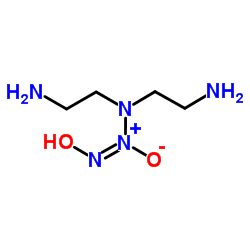DETA-NONOate

DETA-NONOate structure
|
Common Name | DETA-NONOate | ||
|---|---|---|---|---|
| CAS Number | 146724-94-9 | Molecular Weight | 163.178 | |
| Density | 1.5±0.1 g/cm3 | Boiling Point | 303.0±52.0 °C at 760 mmHg | |
| Molecular Formula | C4H13N5O2 | Melting Point | 98-106ºC | |
| MSDS | USA | Flash Point | 137.1±30.7 °C | |
|
In vivo imaging of reactive oxygen species in mouse brain by using [3H]hydromethidine as a potential radical trapping radiotracer.
J. Cereb. Blood Flow Metab. 34(12) , 1907-13, (2014) To assess reactive oxygen species (ROS) production by detecting the fluorescent oxidation product, hydroethidine has been used extensively. The present study was undertaken to evaluate the potential of the hydroethidine derivative as a radiotracer to measure ... |
|
|
Regulation of microglial migration, phagocytosis, and neurite outgrowth by HO-1/CO signaling.
Dev. Neurobiol. 75 , 854-76, (2015) Clearance of infected and apoptotic neuronal corpses during inflammatory conditions is a fundamental process to create a favorable environment for neuronal recovery. Microglia are the resident immune cells and the predominant phagocytic cells of the CNS, show... |
|
|
Preservation of nitric oxide-induced relaxation of porcine coronary artery: roles of the dimers of soluble guanylyl cyclase, phosphodiesterase type 5, and cGMP-dependent protein kinase.
Pflugers Arch. 466(10) , 1999-2008, (2014) Soluble guanylyl cyclase (sGC), phosphodiesterase type 5 (PDE5), and guanosine 3',5'-cyclic monophosphate (cGMP)-dependent protein kinase (PKG) are all dimeric. The present study was to determine the role of their dimeric status in nitric oxide-induced vasodi... |
|
|
The cyclic GMP/protein kinase G pathway as a therapeutic target in head and neck squamous cell carcinoma.
Cancer Lett. 370 , 279-85, (2015) Head and neck squamous cell carcinoma (HNSCC) is an aggressive disease with high mortality. Treatments, which can result in significant morbidity, have not substantially changed in three decades. The second messenger cyclic GMP (cGMP), which targets protein k... |
|
|
Detection of nitric oxide production in cell cultures by luciferin-luciferase chemiluminescence.
Biochem. Biophys. Res. Commun. 465 , 232-8, (2015) A chemiluminescent method is proposed for quantitation of NO generation in cell cultures. The method is based on activation of soluble guanylyl cyclase by NO. The product of the guanylyl cyclase reaction, pyrophosphate, is converted to ATP by ATP sulfurylase ... |
|
|
Ascorbic acid promotes the direct conversion of mouse fibroblasts into beating cardiomyocytes.
Biochem. Biophys. Res. Commun. 463 , 699-705, (2015) Recent advances in the direct conversion of fibroblasts to cardiomyocytes suggest this process as a novel promising approach for cardiac cell-based therapies. Here, by screening the effects of 10 candidate small molecules along with transient overexpression o... |
|
|
Activated microglia cause reversible apoptosis of pheochromocytoma cells, inducing their cell death by phagocytosis.
J. Cell Sci. 129 , 65-79, (2016) Some apoptotic processes, such as phosphatidylserine exposure, are potentially reversible and do not necessarily lead to cell death. However, phosphatidylserine exposure can induce phagocytosis of a cell, resulting in cell death by phagocytosis: phagoptosis. ... |
|
|
Pendrin protein abundance in the kidney is regulated by nitric oxide and cAMP.
Am. J. Physiol. Renal Physiol. 303(6) , F812-20, (2012) Pendrin is a Cl(-)/HCO(3)(-) exchanger, expressed in the apical regions of some intercalated cell subtypes, and is critical in the pressor response to angiotensin II. Since angiotensin type 1 receptor inhibitors reduce renal pendrin protein abundance in mice ... |
|
|
Clinical Implications of iNOS Levels in Triple-Negative Breast Cancer Responding to Neoadjuvant Chemotherapy.
PLoS ONE 10 , e0130286, (2015) Triple-negative breast cancer is a high-risk breast cancer with poor survival rate. To date, there is a lack of targeted therapy for this type of cancer. One unique phenomenon is that inflammatory breast cancer is frequently triple negative. However, it is st... |
|
|
Tipping off endothelial tubes: nitric oxide drives tip cells.
Angiogenesis 18(2) , 175-89, (2015) Angiogenesis, the formation of new blood vessels from pre-existing vessels, is a complex process that warrants cell migration, proliferation, tip cell formation, ring formation, and finally tube formation. Angiogenesis is initiated by a single leader endothel... |